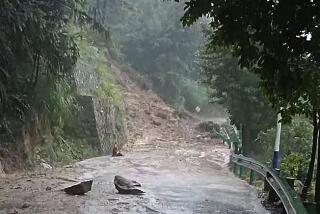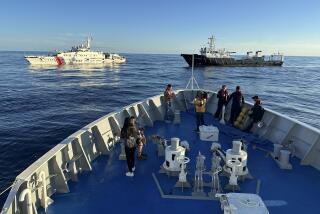From the Archives: Firing Convoys Roam Beijing
BEIJING -- A new wave of fear swept Beijing today as military convoys rumbled through the Chinese capital, firing repeatedly into the air and sometimes at pedestrians, while more armor was sent to reinforce the army’s hold on Tian An Men Square.
About 400 tanks, armored vehicles, troop and munition trucks moved into the square early today following a second day of bloodshed in central Beijing, while other convoys roamed the city around noon.
Gunfire rocked the city’s embassy section at about 1 p.m. as troops moved north past the compound housing the American ambassador’s residence and the press and cultural section of the U.S. Embassy.
During periodic skirmishes near Tian An Men Square and at key intersections Sunday, Chinese troops fired on unarmed residents for the second day and, according to hospital and witness reports, killed scores more people who, seemingly oblivious to the danger, had approached the soldiers.
Hundreds of people were reported killed and many more wounded Saturday night and early Sunday as the government ordered the People’s Liberation Army to crush the student-led pro-democracy protest movement that had occupied the square for weeks.
An exact toll of the casualties in the two days of violence could not be ascertained. The latest estimates, by local medical and diplomatic spokesmen, of the dead in the army’s seizure of the square range from 200 to more than 1,000. Japan’s Kyodo News Service, quoting Red Cross sources, put the total at 2,600 dead and 10,000 wounded.
Various military convoys were moving through the city around noon.
Shooting Near Embassy
“They’re shooting right outside my office!” U.S. Embassy spokesman Andy Koss suddenly shouted in the midst of an early afternoon telephone interview. “They’re army trucks. They’re heading north on the road next to my office. Oh goddam it! It’s unbelievable. They’ve got guns ready, they’re shooting up into the air.”
Before the troops drove by, Koss said the U.S. Embassy was sending officials to Beijing area universities this afternoon “to make contact with American students and see what the situation is.”
Other embassies had already begun evacuating their nationals from university campuses to safer locations in Beijing.
Beijing Mayor Chen Xitong said on the radio this morning that 1,000 troops were injured during Sunday’s violence, in incidents he called “unprecedented” in the 40 years of Communist rule in China.
As the additional tanks and armored personnel carriers were sent to the square between midnight and dawn today, Beijing residents lying in ambush hurled half a dozen firebombs at them near the intersection of Changan Avenue and Dongdan Street. During one ambush at about 3 a.m., an armored personnel carrier briefly caught fire, but soldiers rushed to douse the flames.
There was also sporadic firing during the night around Beijing where people had set up little barricades of vegetable stalls and debris. Crude barriers put up by citizens this morning along Changan Avenue seemed inadequate to stop troop trucks and tanks: An army jeep easily circumvented one of them.
As the death toll mounted, individual citizens continued to display extraordinary physical bravery in acts of defiance.
Man Stops Tanks
A column of 10 tanks and 10 armored personnel carriers that headed east out of Tian An Men Square around noon was stopped by a single man who stood in front of the lead tank, according to a Western witness. He climbed up on the tank, talked with someone inside, then climbed down and walked away alive.
The column continued on its way, firing randomly. It could not be determined whether the shots were going in the air or toward the sidewalk, but about 100 bicyclists followed along beside and behind the convoy.
About an hour later, 90 troop trucks and an equal number of support vehicles rolled past the Beijing Hotel, a famous tourist and business center, and into the square, the witness said. Troops were firing into the air, and some bullets hit the hotel.
Soldiers Surrounded
Late Monday morning, a crowd stood surrounding soldiers at the Jianguomen Bridge, where some people have been shot to death.
“Running dogs!” screamed a woman standing no more than 50 feet from soldiers armed with automatic weapons.
Beginning around 1 p.m., gunfire was heard near the bridge. It was not immediately known whether people were injured or killed, but shortly after 1:30 p.m., an army truck was set on fire on the main highway near the bridge, and ammunition on the truck could be heard exploding.
A witness said the truck had broken down and been left behind when a convoy of about 100 vehicles passed by. Someone took a crowbar, forced open the gas tank and dropped in the burning stuffing from a captured helmet.
Protesters then moved on to at least seven other nearby abandoned army trucks and methodically set them on fire.
Gunfire Continuing
Rifle fire continued off and on through Sunday night. Soldiers were reported to have surrounded two colleges--Beijing Teachers University and Beijing Institute of Aeronautics and Astronautics--but there were no reports of any raids on the campuses.
The continued bloodshed seemed aimed at forestalling resistance to the military clampdown on the city. Still, the randomness and cold-blooded nature of the shootings sometimes made the incidents seem to be acts of pure terror.
50 Bodies on Pavement
Sunday morning, one foreign witness saw the bodies of at least 50 dead on the pavement when troops near the landmark Beijing Hotel fired four volleys of AK-47 rifle fire into youthful throngs.
In a single incident in the afternoon, witnesses reported seeing troops gun down at least 20 people on Tian An Men Square after troops and tanks opened fire on a gathering crowd.
The anonymity of the violence added a sense of unreality. The soldiers wore no unit identifications. No one was sure exactly who had ordered the army to move in crushingly and seize control of Tian An Men Square from pro-democracy protesters. No government official made any statement of explanation.
Announcers on government television repeatedly read news reports that blamed the violence on “a counterrevolutionary rebellion,” asserting that the student movement for democracy was trying to overthrow the Communist Party.
Regime Charges ‘Thugs’
“Thugs in a frenzy attacked People’s Liberation Army troops, seizing weapons, erecting barricades, beating soldiers and officers in an attempt to overthrow the government of the People’s Republic of China,” said the announcement, which was issued in the name of the Beijing Martial Law Headquarters.
Stunned students at Beijing University, the seat of the pro-democracy movement and focus of countless other protest campaigns in modern Chinese history, held memorial vigils on the sprawling campus.
One female student told of seeing classmates crushed beneath the treads of army tanks when they rolled into Tian An Men Square early Sunday to rout protesters who had occupied the enormous square for most of the past seven weeks.
Rail Car of Corpses Reported
One Chinese army officer told a Western colleague that he had seen a freight car piled high with corpses.
An unsubstantiated report circulated among students at Beijing University that four truckloads of dead were moved from Tian An Men Square to the main crematorium at Babaoshan Cemetery in western Beijing.
The students at Beijing University hung pictures of the known dead on walls around the campus. Some students scrawled defiant graffiti on the walls.
“A debt of blood has to be paid back in blood,” said one. Another read: “Now we should fight back.”
In Tian An Men Square, where dozens of tanks and other armored vehicles were parked, blood stained the pavement stones. Ancient gates near the Forbidden City were pocked with bullet holes.
Barricades at Square
Soldiers manned barricades at all the entrances to the square, which is also the site of Mao Tse-tung’s tomb and the Great Hall of the People, Chinese officialdom’s main ceremonial meeting place.
Crowds gathered Sunday afternoon at each approach to the square, only to be driven away by gunfire, sometimes aimed directly at them. The crowds fell back, regrouped and returned in what became acts of almost ritualized, but futile, defiance.
Innocent bystanders also were injured. At Jianguomen, the old eastern entrance to the city, a 65-year-old woman practicing tai ji quan exercises on a highway overpass was hit by gunfire and killed.
As night fell Sunday, protesters gathered on Xidan Street to the west of Tian An Men Square to set abandoned army trucks ablaze. There and elsewhere at major intersections, residents set up makeshift barricades of overturned vegetable stands.
According to one military source here, the unit responsible for much of the shooting has been the PLA’s 27th Army, which is ordinarily based in Hebei province, south of Beijing. That unit is said to be allied with Chinese President Yang Shangkun, top aide to senior Chinese leader Deng Xiaoping on the Central Military Commission.
In contrast, troops from the 28th Army, based west of Beijing, were said to have entered the city but then held back from the random violence. Most of the army units from the Beijing Military District are aligned with Defense Minister Qin Jiwei, who reportedly sided with Communist Party leader Zhao Ziyang in his effort to head off the declaration of martial law in the capital.
Theories on Crackdown
Various theories were advanced here to explain the army’s entry into Beijing and the massive use of lethal force against the demonstrators. One suggested that a virtual coup d’etat was under way. Another suggested that the random violence reflects a struggle for control of the Chinese capital by competing units of the People’s Liberation Army and their commanders.
More to Read
Sign up for Essential California
The most important California stories and recommendations in your inbox every morning.
You may occasionally receive promotional content from the Los Angeles Times.










